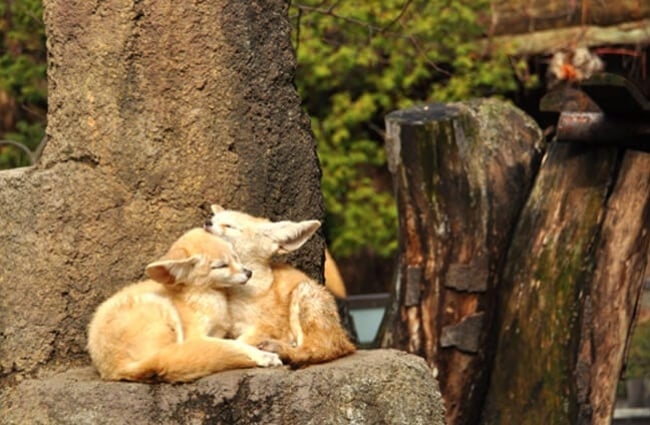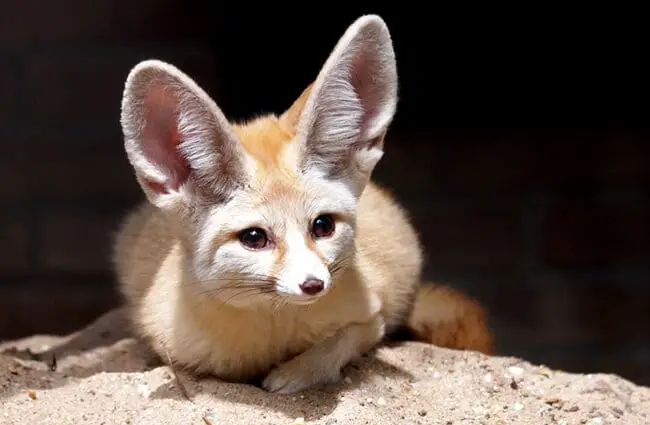Fennec foxes are small mammals native to the Sahara Desert of North Africa. These foxes have large ears and bushy tails, and are the smallest members of the Canine family. Read on to learn about the fennec fox.
Description of the Fennec Fox
Fennec foxes are quite small, and generally weigh no more than 3.5 lbs. or so. They have relatively long, bushy tails with a black tips. These foxes have pale-colored fur tinged with various shades of tan. Of all foxes they have the largest ears, relative to their body size. These long, triangular ears serve to dissipate heat in the scorching environment of the desert.
Interesting Facts About the Fennec Fox
The fennec fox is as cute as it is curious. They are uniquely adapted to desert life, and have a few interesting traits aiding them in survival.
- Heat Loss – In the smoldering temperatures of midday deserts, reducing body temperature is important. Heat stroke is no joke! Fennecs have a few crafty ways to help beat the heat.
- Bat-Ears – There is a good reason these foxes have the largest ears of any fox (again, relative to body size). Their ears have many tiny blood vessels that run close to the surface of the skin. When the blood passes close to the skin it can be cooled by the air outside and reduce the internal body temperature.
- Fur Coat – Fennec fox coats are designed to help them reduce body temperature as well. They are well insulated, slowing body temperature change both hot and cold. They are also lightly colored, and this helps reflect the sun off of their fur.
- The Pitter Patter of Furry Paws – In actuality, you would not be able to hear a fennec fox approach. This is because they have a thick coating of fur on the soles of their feet. The fur protects the fox from burning its toes, while also providing extra grip on soft sand.
Habitat of the Fennec Fox
Fennec foxes live in the deserts of northern Africa. They dig a den in the sand to live and raise pups in, and this den can be either sheltered by vegetation or in the open. Foxes tend to prefer dens in areas with established vegetation and root systems, as their dens can be as nearly 400 ft. long in stable soil. These fox dens can have multiple entrances and chambers.
Distribution of the Fennec Fox
These foxes are found exclusively in northern Africa, specifically in the Sahara Desert. They can be found from Morocco through Egypt, and up north to Niger. They are also found in Israel and Kuwait.
Diet of the Fennec Fox
Fennec foxes are omnivores, which means they will eat both plants and animals. They are generalists, and will eat virtually anything that they can get their paws on. Some of their most common food sources are rabbits, mice, insects, birds, and eggs. They can survive for long periods without drinking water, and are experts at preventing water loss.
Fennec Fox and Human Interaction
While they are not a threat to livestock, humans commonly hunt fennecs. Their furs are highly valued by the indigenous people, but their population appears to be stable. They are commonly captured and traded for the exotic pet trade.
Domestication
Fennec foxes have not been domesticated in any way.
Does the Fennec Fox Make a Good Pet
To an educated and responsible owner, the fennec fox can make a good pet. For the vast majority of people, fennec foxes will not be a good fit. Always research a pet before committing to caring for it.
Fennec Fox Care
Primarily, fennec foxes both in private and zoological ownership should be obtained from established breeding programs rather than the wild. They must be provided with plenty of space for exercise, opportunities to dig and tunnel, hiding spaces, and lots of enrichment.
They can be provided with toys, new scents, varied foods, puzzle feeders, ice blocks, and positive reinforcement training. In human care their diet typically consists of domestic canine kibble, commercial zoo carnivore meat, vegetables, insects, and the occasional rat or mouse.
Behavior of the Fennec Fox
In most situations these foxes will remain in pairs with their offspring. The adult young will even remain to assist in the care of the new litter on occasion. Both young and adults will play with each other, and make a number of sounds like barks, purrs, and growls.
Much of the information that we know about fennec foxes is based on behavior observed in captive individuals. Studying these creatures in the wild can be quite difficult.
Reproduction of the Fennec Fox
These mammals are monogamous, which means that they mate for life. Pairs will control a territory, and their family can consist of this year’s kits, as well as the previous year.
While the female is pregnant, the male becomes very protective of her. He will bring her food, both while she is pregnant, and when she is nursing the kits. After approximately 50 days the female will give birth to as many as four kits.











![Red Angus Closeup of a beautiful Red Angus cowPhoto by: U.S. Department of Agriculture [pubic domain]https://creativecommons.org/licenses/by/2.0/](https://animals.net/wp-content/uploads/2020/03/Red-Angus-4-238x178.jpg)












![Red Angus Closeup of a beautiful Red Angus cowPhoto by: U.S. Department of Agriculture [pubic domain]https://creativecommons.org/licenses/by/2.0/](https://animals.net/wp-content/uploads/2020/03/Red-Angus-4-100x75.jpg)

